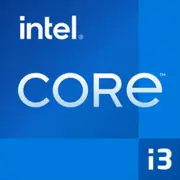Intel Core i3-7101TE

Intel Core i3-7101TE: A Comprehensive Review of the 2025 Processor
Kaby Lake Architecture in the Era of Multicore—Is it Worth Considering in 2025?
Key Specifications
Architecture and Process Technology
The Intel Core i3-7101TE is a member of the Kaby Lake line (7th generation), released in 2017. It is manufactured on a 14 nm process, which by 2025 is considered outdated as modern chips utilize 5–7 nm technology. However, this does not diminish its relevance in niche scenarios.
Key Parameters:
- Cores/Threads: 2/4 (Hyper-Threading enabled).
- Base Clock Speed: 3.4 GHz (no Turbo Boost).
- TDP: 35W – energy efficiency is its main advantage.
- Graphics: Intel HD 630 (supports 4K@60Hz via HDMI/DisplayPort).
- Cache: 3 MB L3.
Performance:
- Geekbench 6: 1188 (Single-Core), 2368 (Multi-Core). For comparison, the modern Ryzen 3 8300G (2024) scores around ~1800/5500.
- Strengths: Stability, low heat generation, support for DDR4.
Compatible Motherboards
Socket and Chipsets
The processor uses LGA 1151, but only v1 revision (not compatible with 8th–9th generation motherboards). Supported chipsets:
- H110, B250, H270, Q270 – budget solutions with basic functionality.
- Examples of motherboards: ASUS Prime B250M-K ($70–90), Gigabyte H270-HD3 ($80–100).
Important!
- BIOS: Newer motherboards in 2025 may lack firmware support for Kaby Lake. Look for models released in 2017–2018.
- Ports: Check for USB 3.1, M.2 (NVMe support available via adapters).
Supported Memory
DDR4 — The Foundation of the Configuration
- Types: DDR4-2133/2400 MHz (officially).
- Modes: Dual-channel – to enhance iGPU performance.
- Maximum Capacity: Up to 64 GB (depends on the motherboard).
Advice: For office tasks, 8 GB is sufficient, and for a media center, 16 GB is recommended. Use modules with low timings (CL15–16).
Power Supply Recommendations
Energy Efficiency vs. Power Reserve
With a TDP of 35W, the processor does not require a powerful power supply, but it's important to consider other components:
- Integrated Graphics: A power supply of 300–400W is sufficient (e.g., EVGA 400 N1, $35).
- With Discrete Graphics Card: For GTX 1650 or RX 6400, choose a power supply of 450–500W (Corsair CX450, $55).
Rule: Don’t skimp on quality. Cheap power supplies can damage components.
Pros and Cons
Why Should (or Shouldn’t) You Consider the i3-7101TE in 2025?
Pros:
- Energy Efficiency: Ideal for compact PCs (HTPC, office builds).
- Price: New units are priced around $60–80 (cheaper than most modern analogs).
- Stability: A well-established platform with no "growing pains."
Cons:
- 2 Cores: Multitasking is limited (Chrome + Word + background music = 100% load).
- Outdated Architecture: Lags behind even budget Ryzen 3s from 2024 in IPC.
- No PCIe 4.0/5.0: NVMe drive speeds are limited to 3.0.
Use Cases
Where is the i3-7101TE Still Relevant?
1. Office PCs: Document work, video conferencing, web surfing.
2. Media Centers: 4K playback via HDMI 2.0, streaming services.
3. Light Gaming: CS:GO, Dota 2 – 720p/low settings (up to 40-50 FPS).
4. Thin Clients: For working with cloud applications.
Limitations: Video editing, 3D rendering, modern AAA games (Cyberpunk 2077, Starfield) – not recommended.
Comparison with Competitors
Kaby Lake vs. Modern Budget Chips
1. AMD Athlon 3000G (2025, $65):
- 2 Cores/4 Threads, Vega 3 (gaming at 720p).
- Pros: Cheaper, PCIe 3.0 support.
- Cons: No AVX2.
2. Intel Pentium Gold G7400 (2025, $90):
- 2 Cores/4 Threads, UHD 710.
- Pros: New Alder Lake architecture (IPC +18%), DDR5 support.
- Cons: Higher price.
Conclusion: The i3-7101TE only wins in second-hand market prices. New builds are better off with modern CPUs.
Practical Assembly Tips
How to Build a PC with i3-7101TE in 2025?
1. Motherboard: Look for B250/H270 with warranty (for example, ASRock B250M-HDV).
2. Memory: 2×8 GB DDR4-2400 (Patriot Signature Line, $35).
3. Storage: Kingston A400 480 GB (SATA III, $30) or NVMe via adapter.
4. Case: Mini-ITX (Cooler Master Elite 110, $50) for a media center.
5. Cooling: The stock cooler is sufficient (temperature up to 65°C).
Hack: Use Linux (Ubuntu/Linux Mint) to reduce CPU load.
Final Conclusion: Who is the i3-7101TE Suitable For?
This processor is a choice for:
- Enthusiasts on a budget assembling PCs for basic tasks.
- Corporations updating their office computer fleets.
- Retro build enthusiasts on the LGA 1151 platform.
Alternative: If the budget allows for $100–150, consider used Intel Core i5-8400 (6 cores) or a new Ryzen 3 8300G.
Price in 2025: New i3-7101TEs are rare; expect to pay $60–80. But remember, for the same price, you can find more powerful options on the second-hand market.
Conclusion: The Intel Core i3-7101TE is an example of a "workhorse" that has outlived its era. It may not impress in benchmarks, but it is ideal where reliability and minimalism are important.
Basic
CPU Specifications
Memory Specifications
GPU Specifications
Miscellaneous
Benchmarks
Compared to Other CPU
Share in social media
Or Link To Us
<a href="https://cputronic.com/index.php/cpu/intel-core-i3-7101te" target="_blank">Intel Core i3-7101TE</a>